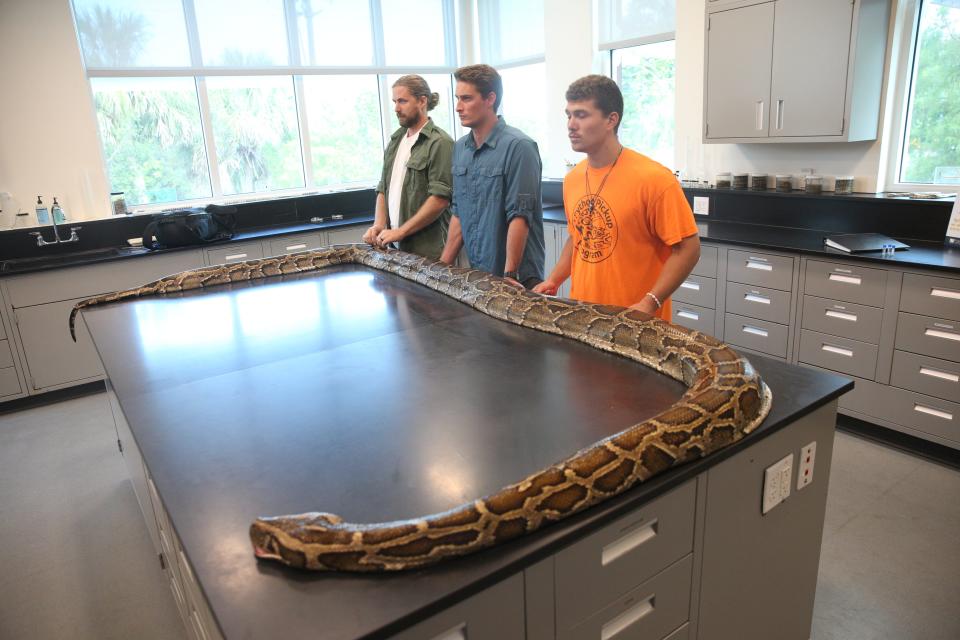Researchers: Asian crustacean is invading the lungs of south Florida's native snakes
They're among the longest predators on the planet, and they creep through the woods, unseen and unheard.
For some, Burmese pythons are nightmarish creatures that grow up to 19 feet in Florida (one that length was captured near Naples last month).
Some tiny crustaceans, however, attack Burmese pythons, and those same little critters are infecting Florida's native snakes, according to leading researchers on the invasive species and the creatures that live inside them.
The process involves the strange life cycle of parasites, microscopic animals that infect hosts and often spread from one species to another as they morph from stage to stage.
"The female parasite will produce eggs and those eggs will be excreted with the feces or through the respiratory system, and that’s how they’re getting out and into the environment," said Melissa Miller, a parasitologist and python parasite researcher at the University of Florida in Gainesville.

Miller studies parasites like the often-microscopic crustaceans that have infected the lungs of native snakes in many areas of south Florida, the region where Burmese pythons have established a breeding population that is likely permanently established.
Parasites of this variety change life cycles as they transfer from host to host.
Once freed from their original host, parasites will move on to a second victim, which to them is nothing more than a living habitat and another life phase.
Dozens of parasites can live in the lung of one snake
It starts with adult females that are already established in snakes like the coachwhip.
"Those eggs infect food sources and water sources and," Miller said. "There are multiple intermediate hosts that will be part of the lifecycle. Often a beetle or a roach is in the equation. (The parasite) is eaten by the bug and then a shrew and then a native snake. So, it kind of propagates itself."
Miller said some native snakes she examines have several parasites in each lung, and that each individual can grow to 3 inches in length.

"That's a large parasite to have in your lungs," Miller said. "We had a coachwhip snake that had 77 parasites clogging it’s lung. The snake was trying to compete for resources and breath, and if you have 77 parasites in your lungs, that could be very difficult."
More: Florida panther disease may be caused by harmful algae blooms around preserve lands
Native snakes she's examined have also had a higher rate of parasite infection than that found in invasive Burmese pythons.
The native species appear to be able to spread it among themselves as the parasite has been found in snakes living north of Lake Okeechobee, which is likely the northern boundary of the Burmese python range at this point.
Christina Anaya is a biologist and professor at Florida Gulf Coast University, and she studies parasites in hopes of discovering how they impact native species.
"They’ll shed in the host and that will cause inflammation," Anaya said. "When you introduce a parasite they’re not familiar with, they call it immunologically naïve ― so all the impacts you can get from an infection can be much worse because it’s the first time they’ve interacted."
Burmese pythons have relatively few parasites
The cycle continues, and the parasites morph in shape from one host to the next.
"They’re pooping out the parasites and if there is a host, the parasite might be able to infect another host, or another native species is eating whatever the parasite got into," Anaya said. "Parasites can live anywhere, like ticks and fleas and lice and all the internal ones. Every animal on the planet has parasites. They have two or three or 10 living in them at one time."
Anaya said the Burmese pythons evolved with the parasite in Asia and that those snakes are not greatly impacted by the tagalongs.
More: 'It hasn't been a guacamole year' on Lake Okeechobee, contrary to reports, scientist says
"We hardly find any of these crustaceans in the pythons that we go through," said Anaya, who has examined dozens of Burmese pythons along with research students in Gainesville. "Parasites don't always infect every single host. We’ve only found two out of the snakes we’ve gone through, so that’s not a lot."
So the lung crustacean doesn't seem to be all the problematic to the Burmese python, but it's being found in much higher concentrations in native snakes since they didn't evolve with the Asian parasite.
"We’re finding them at a higher rate in the native snakes," Anaya said. "Definitely."
Connect with this reporter: Chad Gillis on Facebook.
This article originally appeared on Fort Myers News-Press: Python parasites attacking Florida snakes, growing to 3 inches in lungs

